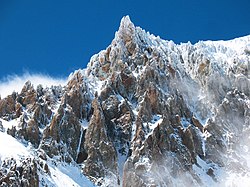Aysén Region
|
Región Aysén del General Carlos Ibáñez del Campo. XI Región Aysén del General Carlos Ibáñez del Campo |
|||
|---|---|---|---|
| Region of Chile | |||
 |
|||
|
|||
 Map of Región Aysén del General Carlos Ibáñez del Campo. |
|||
| Coordinates: 43°34′12″S 72°03′58″W / 43.57000°S 72.06611°WCoordinates: 43°34′12″S 72°03′58″W / 43.57000°S 72.06611°W | |||
| Country |
|
||
| Capital | Coyhaique | ||
| Provinces | Coyhaique, Aysén, General Carrera, Capitán Prat | ||
| Government | |||
| • Intendant | Pilar Cuevas Mardones (Ind) | ||
| Area | |||
| • Total | 108,494.4 km2 (41,889.9 sq mi) | ||
| Area rank | 3 | ||
| Lowest elevation | 0 m (0 ft) | ||
| Population (2012 census) | |||
| • Total | 94,271 | ||
| • Rank | 15 | ||
| • Density | 0.87/km2 (2.3/sq mi) | ||
| ISO 3166 code | CL-AI | ||
| Website | Official website (Spanish) | ||
The XI Aysén del General Carlos Ibáñez del Campo Region (Spanish: Región de Aysén or XI Región Aysén del General Carlos Ibáñez del Campo), often shortened to Aysén Region or Aisén, is one of Chile's 15 first order administrative divisions. Although the third largest in area, the region is Chile's most sparsely populated region with a population of 100,417 as of 2002. The capital of the region is Coihaique, the region's former namesake.
The Aysén Region is the least populous of Chile's fifteen regions. The landscape is marked by several glaciations that formed many lakes, channels and fjords. The region still contains icefields including the Northern Patagonian Ice Field and the Southern Patagonian Ice Field, the world's third largest after those in Antarctica and Greenland. Laguna San Rafael National Park, reachable only by boat or plane, is one of the region's most popular tourist destinations. Until the construction of Route 7 (the Carretera Austral, or Southern Highway) in the 1980s, the only overland routes from north to south through the region were extremely primitive tracks.
The Coyhaique region was the last to be joined to make the country, long after even the southernmost region of Magallanes and Chilean Antarctica. Its geographical location and transport difficulties explain the lack of interest aroused in the nineteenth century for these lands, to the point that no one even thought of colonizing them with immigrants, as happened with the other southern regions. Following the signing of the Boundary Treaty with Argentina in 1881, settlers came from the Pampas to the valleys that cross the Andes from east to west. The anonymous and private effort led to the spontaneous creation of cities in Puerto Aysen in 1904, Balmaceda Coyhaique in 1917 and 1929. The oldest of the towns is Melinka (the local legend says that it is "darling" or "lovely" in Russian, but it is not), established by mid-nineteenth century, on Ascension Island, the archipelago of the Guaitecas.
...
Wikipedia


